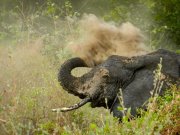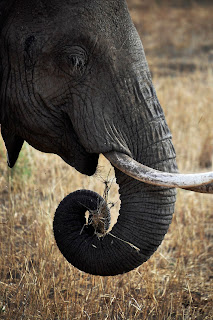It is now 2 days before I
am on a plane back to go home. But, before I can talk about all of the feelings
associated with that, I want to catch you up on all of the amazing things that
have been taking place here.
 |
| EP DR Group |
One incredible
opportunity we have here in the School for Field studies is to experience
directed research (DR). In this process, we take the last 4 weeks of the
program, and commit to an on-going research objective of the school with an
advisor. This research continues for up to 5 years, and the results directly
impact the community. The project options for our group were mapping and
assessing the quality of the water in a nearby river (Ecology), mapping
wildlife sanctuaries and wildlife abundance within them (Wildlife Management),
and assessing how land change has affected the wildlife conservation,
livelihoods and environment (Environmental Policy). I committed to working with
the Environmental Policy (EP) DR. I am really passionate about interacting directly
with the community and trying to directly learn about their problems, and also
research, on ways that they can be helped.
For our project, we spent
8 days traveling all throughout the district that we live in to people’s homes.
We would be dropped off early in the morning and wander through people’s homes
and farms seeing if anyone would have time to talk to us. In America this kind
of approach to gaining information would be ill received as few people make
time to talk to strangers that wander into their house. But within the entire 8
days, not one of the 255 households turned us away. Every family was interested
in talking to us, and giving up a half hour to our research. Just another one
of the reason’s this place has me enraptured.
 |
| This is one of the farms we interviewed |
During this research, we
would ask them many questions regarding how their farms were doing, and if they
were having problems with the land quality and the wildlife in the area. Back
in America it is very easy for us to instantly fall in love with the African
animals – especially the beloved elephants. But these animals in the wild are
not only extremely dangerous, but cause extraordinary damage to the people’s
farms here. During the dry season the elephants run out of food in the national
parks and will leave the protected area and raid the surrounding farms for
their crops. Out of the people we interviewed, over 60% of them told us that
the elephants were coming every single
night into their farms and about 35% of these people had almost their
entire farm destroyed by elephants. To add insult to injury, the government has
this wildlife thoroughly protected, so that if one is killed or injured the
people are fined and put into jail. However, if an elephant kills a person,
there is almost no compensation, and the government doesn’t really care. Over
and over we heard the people telling us that the government cares more about
the animals than they do about the people.
 |
| Heated debate over water access |
At almost every interview
I went to, these people were in dire need of help to prevent the elephants from
doing damage. Many farmers have to spend the nights sleeping in their fields in
order to protect them, and others have not the slightest idea of how to stop
them from destroying their crops. The hardest part of all, at each and every
house the people would ask us “are you going to help us?” I still feel the
weight of this question on my shoulders and a hundred different people’s eyes
looking at me desperately. I wanted to tell each person that help was on the
way, that we were going to make a difference, that they wouldn’t have to worry
any more: but it would be foolish to tell them this. To actually make a
difference in these people lives would take years of planning and policy
debates.
 |
| Community Presentation |
Throughout this whole
process we knew that with this research we were going to gather the community
leaders, chiefs, managers, school teachers and politicians into one room to
hear what we found. I would tell each household that this would be the case,
and this would give some homes hope.
After analyzing the
research, and a week of writing up a 52 page report on the information (and you
wonder why I don’t blog more often), it was time to present. Nothing has ever
made me so nervous. I practiced and researched for 2 days straight on what I
was going to tell the community. Because I felt so strongly about doing what I
could in the moment to help these people, I took charge of addressing our
recommendations and conclusion as well as areas for future research. I
struggled with the information as I tried to decide on what I could possibly
say and recommend that might make a difference in someone’s house somewhere.
I finally decided that
the best way that I could the people is giving them information on what I had
learned researching on the best ways to individually prevent elephants from
entering their farms. Although this is far from solving the problem, it is at
least a tangible step that the people could make today if they wanted to that
could better their livelihoods.
 |
| Chris and I listening to presentations |
The ideas I found,
although tested to be effective, sound crazy (not helping my nervousness). One
idea is planting trees. The can make money from the timber, it helps their
soil, decreases erosions and a whole slew of other important things. Next is
planting crops that elephants won’t eat – like tea and cotton and chili
peppers. However, a lot of the people use their crops for subsistence, and so
having to transfer to cash crops would be a considerable change in livelihood.
I told them about how chili peppers can be made into a paste, or sprayed into
the air. The smell of this really irritates elephant’s trunks, and they will
run from the smell. Another really interesting tactic along this line that is
being tested in Zimbawe is the put chili powder into ping pong balls, and fire
them from a gun so that they explode on the elephants (Do I sound crazy yet?).
Another recommendation I suggested was this really cool idea of building bee
hive fences. These fences, oddly enough, are extremely effective at deterring
elephants. These massive, powerful creatures, cannot for some reason, stand the
sound of bees. Even though people laughed when I told them about this, I think
with time and testing, this could make a huge difference in these people’s
lives.
 |
| Talking about this Bee Hive Fence to the Community |
I don’t think anything
else can ever compare to how nerve racking it is to get up in front of a
community, who doesn’t speak your language and whose culture is so different
than yours, and try to explain to their most respected leaders ideas for making
their lives better. At least that means dating and tests will be a piece of
cake. The people seemed to be interested, and even heatedly debated our ideas
between themselves and asked us many questions. I take this as a good sign –
even though it was terrifying to handle in the moment.
But in all reality, I
pray feverently that something we said will be put to use, somewhere. I am
hoping to do some more research and work on contacting leaders when I return
home as well. I have the data to back it up – I have the people’s plees for
help. All they need is for someone to link these and get the word out.
 |
| Serving the community Lunch after the Presentations |
I am still reflecting on
this whole 4 week project, and still have trouble fathoming all that has been
accomplished by our group in this month. I am inspired and can only hope that I
can help this community more in the future and continue to work with this
issues that so many people know nothing about. In order to make sure elephants
are not harmed, as well as that people are being helped, people need to be
aware of these conflicts. I am going to publish my paper when I return home and
maybe that will be a small step towards help.















































